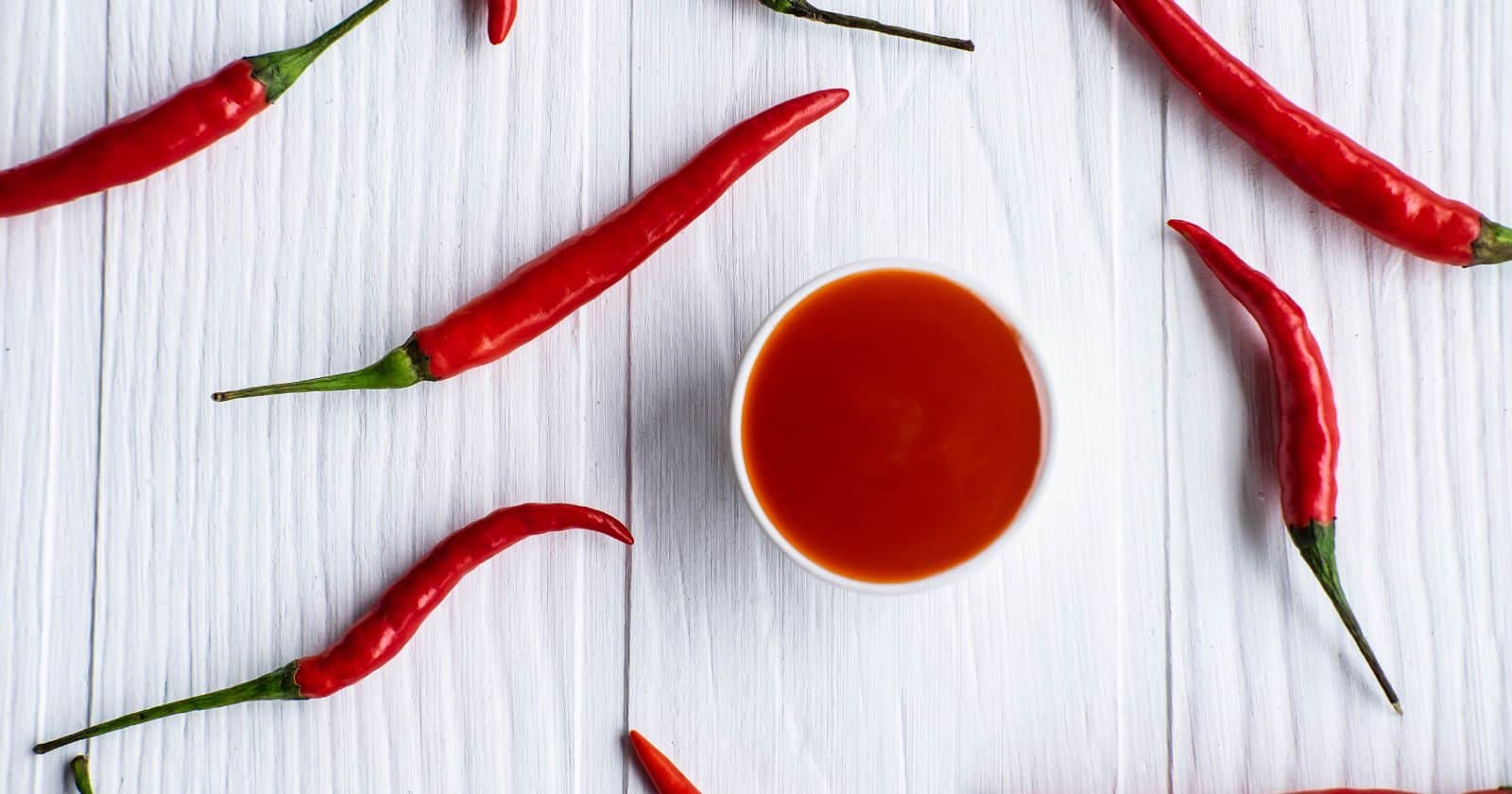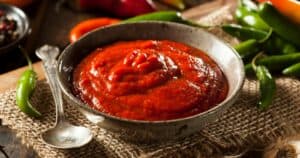Do you love adding a kick of heat and flavor to your meals? If so, you’re probably very particular about your hot sauce selections. But with so many options on the grocery shelves, how do you know which hot sauces are mild, medium, or blow-your-head-off spicy?
The scoville scale is the universal standard for measuring a chili pepper’s heat and rating hot sauces. Created by chemist Wilbur Scoville in 1912, this handy scale measures the amount of capsaicin in a pepper or hot sauce. Capsaicin gives chilis and hot sauces their characteristic heat sensation.
The scoville heat units (SHU) indicate the amount of capsaicin in a particular hot sauce or pepper. A higher scoville rating means the sauce contains more capsaicin and packs more heat. As a reference point, a jalapeno pepper registers around 5,000 SHU.
Hot sauces can range from a mild 500 SHU to wild, mouth-searing intensities of over 2 million SHU. When deciding which hot sauce to buy or sample, look at the scoville rating to determine if it aligns with your degree of desired spiciness. Mild hot sauces register below 1,000 SHU, medium from 1,000 to 25,000 SHU, hot from 25,000 to 200,000 SHU, and extreme hot sauces exceed 200,000 SHU.
Beyond heat level, you can also choose hot sauces based on sodium content, flavors, and overall taste profile. As you become more of a chile-head, understanding scoville ratings will help you navigate the wide world of hot sauces so you can find your perfect blend of heat.
Now let’s explore the scoville scale in more detail so you can become a hot sauce expert!
What Is the Scoville Scale?
The scoville scale measures the concentration of capsaicin in a pepper or hot sauce. Capsaicin is the chemical compound in chilis and hot sauce that stimulates heat receptors on your tongue, creating a burning sensation.
In 1912, chemist Wilbur Scoville devised a test to measure capsaicin levels. The scoville scale rates the spicy heat in terms of scoville heat units (SHU). A hot sauce’s SHU indicates how much diluted capsaicin extract it takes to no longer taste the heat. The higher the number, the more scoville units, and the hotter the sauce.
On the scoville scale:
- A rating of 0-100 SHU means no perceivable heat
- 100-1,000 SHU indicates a mild heat
- 1,000-25,000 SHU is a medium heat
- 25,000-200,000 SHU is hot
- Above 200,000 SHU is extreme heat
To put it into perspective, a jalapeño pepper ranges from 2,500 to 8,000 SHU. So at around 5,000 SHU, jalapeños bring a medium heat that makes your mouth tingle.
Reading Scoville Ratings on Hot Sauce Labels
Checking out the scoville rating on a hot sauce bottle helps you gauge its heat intensity so you can handle the burn. Those ratings are science-based indicators, not just marketing hype.
For example, you’ll see ratings like:
- Sriracha: 1,000 to 2,500 SHU – A mild to medium heat popular in many Asian dishes
- Cholula: 3,600 SHU – A medium heat with a tangy, chili-lime flavor
- Tabasco: 2,500-5,000 SHU – The classic red pepper sauce has a medium heat
- Frank’s Redhot: 450 SHU – A tangy, buttery favorite for buffalo wings
Knowing these scoville ratings lets you pick a hot sauce aligned with your comfort level. If you’re
The Hottest Hot Sauces
While jalapeños hit around 5,000 SHU, the hottest peppers and sauces climbing up from there into the millions. Ready to really turn up the heat? Here are a few scorching hot options:
- Habanero – 100,000 to 350,000 SHU – Habaneros offer a fiery, fruity flavor.
- Ghost pepper – 855,000 to 1,041,427 SHU – The potent ghost pepper gives an intense burn.
- Carolina Reaper – 1,400,000 to 2,200,000 SHU – Currently the world’s hottest pepper.
- Mad Dog 357 – 357,000 SHU – A super-hot sauce using extract for extreme heat.
- Blair’s Ultra Death Sauce – 800,000 to 1,000,000 SHU – One of the hottest sauces made from a dangerous mix of chili extracts.
These sauces and peppers blow jalapeños out of the water. Just a drop or light sprinkle of these fiery sauces brings some serious mouth-searing heat.
Factors Affecting Hot Sauce Heat
A hot sauce’s scoville rating reveals its potential heat level. But other factors also affect the intensity you’ll perceive when eating it:
- Personal tolerance – Everyone has a different sensitivity and preference for spicy heat. The more you eat spicy foods, the more you build up a tolerance.
- Quantity used – Obviously, pouring on more hot sauce means more heat. Dabbing on just a couple drops may provide a milder heat.
- Method of application – Hot sauce directly on your tongue amps up the heat versus an even mix throughout a dish.
- Pairings – Hot sauce paired with cooling foods like yogurt and sour cream tamps down the burn.
So a sauce’s scoville rating is a helpful starting point, but your personal preferences factor in too. Test out small amounts of a hot sauce to see if it matches your comfort level before slapping it on all your snacks.
Choosing a Hot Sauce
With thousands of hot sauces available, use the scoville scale to find ones with the right amount of kick for your tastes. Here are some other factors to consider when choosing a hot sauce:
- Ingredients – Check the ingredients list for added flavors beyond chili peppers, like fruits, vegetables, vinegar, spices, etc. The extras impact the hot sauce’s overall taste.
- Sodium content – Many hot sauces are high in sodium, so opt for lower-sodium varieties if that’s a concern.
- Texture – Sauces range from thin and vinegary to thick and paste-like. Consider if you want a smooth or chunky texture.
- Use – Think about how you’ll use the sauce. Will you add it to cooked dishes or just dash it on top of foods?
Handling Hot Sauce Heat
Hot sauce rookies should ease into the spicy world so you don’t overwhelm your tastebuds. Here are some tips for managing hot sauce heat:
- Start with mild sauces under 1,000 SHU and work your way up as you acclimate to capsaicin.
- Add small amounts of hot sauce at first, then increase to your comfort level.
- Put hot sauce on the side for dipping rather than pouring it directly on food.
- Drink milk, eat yogurt, or have other dairy foods to tame the burn by washing away the capsaicin oils.
- Avoid rubbing your eyes after handling hot peppers to prevent irritation. Wash your hands!
- Try growing your own hot peppers. Start with jalapeños or serranos, then experiment with habaneros or Thai chili peppers to move up the scoville scale.
Frequently Asked Questions
1. What are some tasty hot sauces for beginners?
Some good starter hot sauces in the mild range of under 1,000 SHU include Tabasco, Cholula, Sriracha, and Franks RedHot. These give a gentle tingle of heat along with dynamic flavors.
2. Do scoville ratings stay the same between different batches?
No, scoville ratings can vary slightly between different batches of the same hot sauce. Factors like rainfall affecting chili pepper crop yields and ingredient variations can alter the heat level somewhat. But the ratings generally remain in a similar range.
3. How long does the burning last after eating a very hot sauce?
It depends on your individual sensitivity, but very hot sauces over 100,000 SHU can cause a burning sensation that lingers up to 30 minutes. Beverages like milk help calm the spicy burn more quickly. Avoiding further irritation by not rubbing your eyes is also recommended.
4. Is scoville rating the only factor to consider when buying hot sauce?
No, the ingredients, sodium content, texture, intended use, and overall flavor profile all make a difference too. But the scoville rating is a key starting point for understanding the level of heat.
5. What’s the best way to store hot sauce?
An unopened bottle of hot sauce can be stored in a cool, dry place like a pantry for up to 3 years. After opening, it’s best stored in the refrigerator to maintain freshness for up to a year. Keeping hot sauce tightly sealed and away from light extends its shelf life.
Are You a Chile Head?
After learning about scoville units, you can better navigate the spicy world of hot sauces. But growing your heat tolerance takes time. Move up the scale slowly, and beware sauces using dangerous chili extracts that can do more than just burn your mouth.
Hopefully this guide turns you into a hot sauce pro, ready to take on any amount of heat. Just don’t dash on super-spicy sauces without caution. You’ll catch more flavor and avoid torturing your tastebuds if you know and respect a sauce’s scoville rating.
So grab some chips and start a hot sauce tasting party! Have fun finding new favorite flavors, and get your scoville on.





